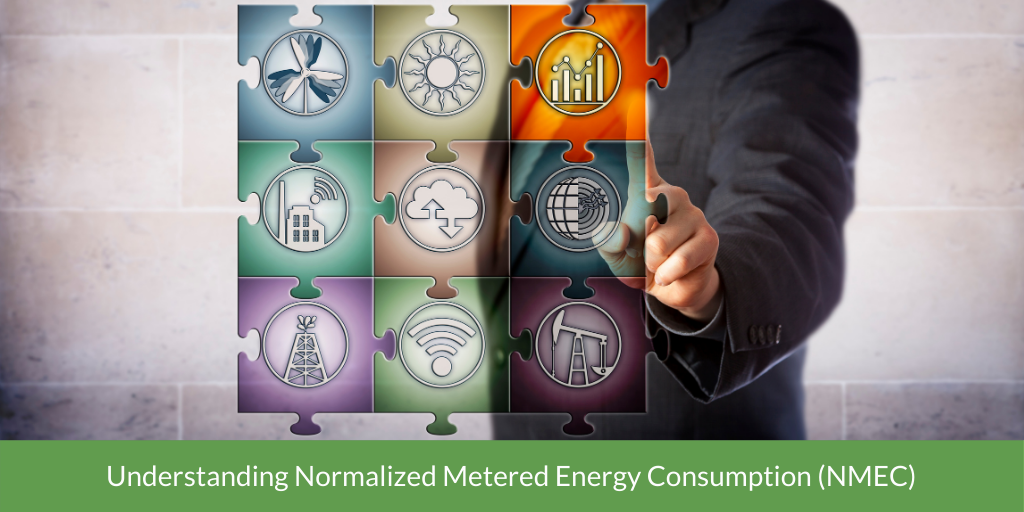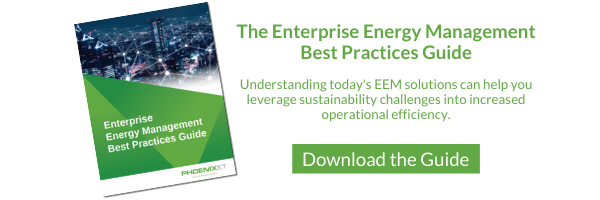Share this
Understanding Normalized Metered Energy Consumption (NMEC)
by Phoenix Energy Technologies on Dec 7, 2020

Energy conservation is a global concern, and governments worldwide are developing policies to place mandates on consumption. These regulations will require programs and protocols that track and isolate ways to reduce usage. California has developed a new metric based on normalized metered energy consumption, or NMEC. These regulations provide energy savings data that help improve building performance.
What is NMEC?
NMEC is sometimes referred to as Measurement and Verification (M&V). In particular, California has an M&V budget through the California Public Utilities Commission (CPUC) to evaluate energy savings potential and improve delivery methods for current energy-saving programs.
NMEC was developed to provide a more accurate way to measure how much energy efficiency you can get out of a building retrofit project. What NMEC does is normalize all the variables that can affect the overall efficiency of a retrofit. Some of the variables that NMEC takes into account from the existing building to the newly retrofitted building are:
- Climate changes
- Building usage changes
- Building operational changes
- Efficiency improvements
Balancing Cost and Comfort: The Case for Always Occupied Setpoints
Goals of NMEC in Improving Energy Efficiency
Using this type of exacting methodology focuses on achieving three goals:
- Lowering M&V costs - NMEC provides specific data that can eliminate the need for costly engineering estimates. Software that calculates the exact conditions from metered data can provide real-time information for allocating funding and creating more specific regulations.
- Using a grid resource for energy consumption - Having specific data on grid consumption quantities and timeframes informs usage criteria for utilities, such as peak times for electric car charging.
- Quantifying value - As a measurable means of tracking energy efficiency, this encourages building owners of the value of the investment. This also gives building operators better insight into their buildings energy use and what consumption benchmarks to set.
Implementing NMEC in Building Operations
In theory, the process of gathering real-time data seems simple. While the concept is straightforward, infrastructure must be in place to aggregate this type of data. Measurements must be taken at the equipment level to provide specific data that can then be aggregated on a building level. The process for putting NMEC in place is as follows:
- Metering devices - Smart metering devices must be installed at a micro level on all energy consuming equipment–or at a more macro level depending on a project's budget. Chillers, HVAC systems, and electrical and lighting panels can all be equipped with smart meters that communicate back to an automation system where energy consumption, power consumption, and peak load times are captured.
- Building automation systems - This is the ‘brain’ of the building that allows the building owner to control system operations for building comfort and energy consumption. With smart meters, they can also aggregate the power consumption from specific equipment and building areas.
- Software - NMEC software can use the data captured by the Building Automation System and generate real-time charts and graphs giving a picture of building usage. Data is also used to make projections and consider variables such as humidity, temperature, high occupancy, and other factors.
- Data analysis - The end-user can use the data provided to make decisions about building operations and energy savings programs. This gives a clear picture of where and how improvements from a retrofit project have improved energy efficiency and provides data necessary to make adjustments for further improvements.
Driving Comfort & Safety Across PetSmart's 1,600 Stores During COVID
NMEC eliminates the guessing game associated with unknown variables in a building that can negatively affect energy consumption and gives a clear picture of where and when there is usage.
For more guidance on building energy management, check out our Enterprise Energy Management Best Practices Guide outlining how to pull real-time building data and how to use building analytics to predict energy consumption and budgets.
Additional Resources:
Increasing Energy Savings During Demand Response Events
Shopper and Employee Comfort and Safety in a COVID-19 Environment
Building Intelligence Just Got Better - Introducing BI 2.0
Share this
- Facilities Management (90)
- Energy Management (69)
- Company News (49)
- Smart Buildings (37)
- Retail (36)
- Building Management (24)
- Building Automation Systems (21)
- Energy Demand Management (19)
- Sustainability (19)
- EEI (15)
- Adaptive Energy Management (14)
- Grocery (14)
- demand response (14)
- Artificial Intelligence (12)
- Data Integration and Visibility (10)
- HVAC IQ (9)
- COVID-19 (8)
- Customer Spotlight (8)
- Carbon Management (7)
- Setpoints and Temperatures (7)
- Equipment Maintenance (6)
- Operational Efficiency (6)
- Ask Ron (5)
- Asset Manager (5)
- Finance and Procurement (5)
- IoT and Digital Transformation (5)
- Refrigeration Optimization (5)
- Awards (4)
- Comfort (4)
- Energy & Store Development (4)
- Safety and Compliance (4)
- Demand Charge Management (3)
- Energy Management System (3)
- Premium Services (3)
- Automated Demand Response (2)
- ConnexFM (2)
- Customer Service (2)
- HVAC Vendor Management (2)
- Lifecycle Asset Management (2)
- Load Shedding (2)
- Refrigeration IQ (2)
- Technician View (2)
- Analytics (1)
- Data (1)
- Data Integration and Visualization (1)
- EMS (1)
- Knowledge Center (1)
- OSHA (1)
- asset management (1)
- November 2025 (1)
- October 2025 (2)
- September 2025 (1)
- August 2025 (3)
- July 2025 (1)
- June 2025 (1)
- May 2025 (2)
- March 2025 (2)
- February 2025 (1)
- January 2025 (2)
- December 2024 (2)
- October 2024 (1)
- September 2024 (1)
- August 2024 (2)
- June 2024 (2)
- April 2024 (2)
- March 2024 (2)
- January 2024 (1)
- December 2023 (1)
- October 2023 (2)
- September 2023 (2)
- August 2023 (2)
- July 2023 (1)
- May 2023 (2)
- April 2023 (2)
- March 2023 (3)
- February 2023 (1)
- January 2023 (1)
- December 2022 (1)
- November 2022 (2)
- October 2022 (2)
- September 2022 (1)
- May 2022 (2)
- April 2022 (1)
- March 2022 (3)
- February 2022 (2)
- January 2022 (4)
- December 2021 (2)
- November 2021 (3)
- October 2021 (1)
- September 2021 (3)
- August 2021 (4)
- July 2021 (1)
- June 2021 (2)
- May 2021 (1)
- January 2021 (2)
- December 2020 (2)
- November 2020 (2)
- October 2020 (3)
- September 2020 (4)
- August 2020 (3)
- July 2020 (2)
- June 2020 (3)
- May 2020 (3)
- April 2020 (5)
- March 2020 (5)
- February 2020 (4)
- January 2020 (4)
- December 2019 (4)
- November 2019 (3)
- October 2019 (4)
- September 2019 (5)
- August 2019 (4)
- July 2019 (4)
- May 2019 (2)
- April 2019 (3)
- February 2019 (1)
- December 2018 (1)
- November 2018 (1)
- October 2018 (3)
- September 2018 (3)
- August 2018 (3)
- July 2018 (3)
- June 2018 (3)
- May 2018 (1)
- June 2015 (1)
- March 2013 (1)
- January 2013 (1)
- December 2011 (1)
- October 2011 (1)
- September 2011 (1)


